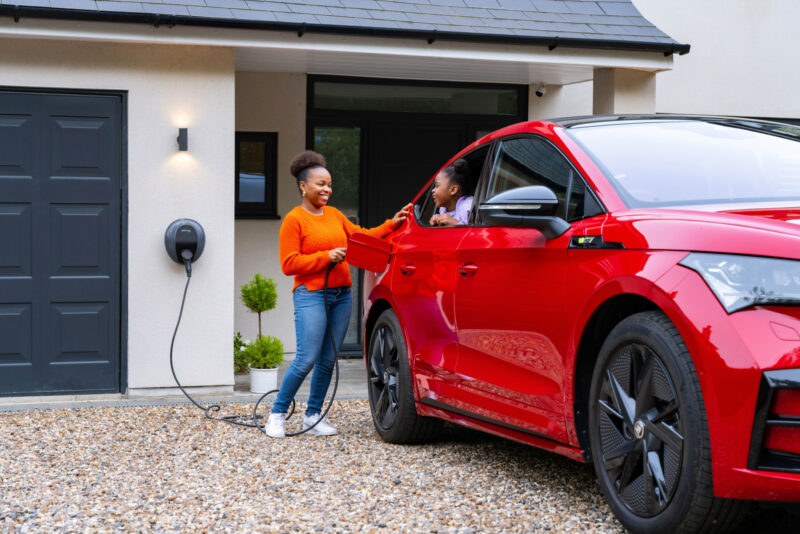Your Guide to Choosing an EV
Everything you need to know about electric vehicles (EVs), helping you make the right choice when switching to a greener way of driving.
Last updated: Aug 28, 2025 • 8 min read

Summary
Before choosing an EV, you should consider how you’ll fund the purchase, what your driving habits are and what range will meet your needs.

Why choose an EV
If one thing’s for certain, the future of transport will be electric. The number of EVs on UK roads continues to reach new heights, with a record 315,000 new electric cars registered in 2023. That’s 18% up from the previous year.
The incoming 2035 ban of new internal combustion engine (ICE) cars, like diesel and petrol, will make the switch to electric driving even more attractive and affordable.
As the future of transport is shaping up to be more sustainable, choosing an EV could be a smart way to future proof your vehicle in a world that is moving away from fossil fuels and toward renewable energy.
What type of EV do you want to purchase?
Battery electric vehicle
A battery electric vehicle or BEV is 100% powered by a battery that stores and releases energy to work an electric motor. It’s the most sustainable way of driving, especially when charged using renewable energy from sources like solar, wind, hydro or biomass.
Most BEVs offer ranges of 250 miles or more on a single charge, which is plenty for daily commutes, school runs and trips to the shop. With some strategically placed public rapid charging stops, you can travel longer distances without significant disruptions.
However, a BEV may not be the best option for you if you regularly tow caravans or trailers, as most aren’t approved for towing or have a limited towing capacity when compared to diesel cars.
Full or mild hybrids
Hybrid vehicles use a combination of electric motor and internal combustion engine to power their driving. They still rely on petrol and diesel, making them a lot less sustainable than fully electric cars.
Not all hybrids are made the same. You have to charge a mild or plug-in hybrid with a chargepoint, while full hybrids recharge their small batteries with the energy generated from driving on petrol or diesel fuel and from braking.
If you frequently drive on the motorway, a hybrid car may not be the best choice for you. They’re less efficient in this scenario, meaning you’ll use more fuel than in an urban environment.
Not sure how to choose a car that’s right for you? Find out more about the different types of hybrid vehicles and the pros and cons of each EV in our guide on buying a hybrid vs electric car.
How to purchase an EV
Personal Contract Purchase (PCP)
PCP is a popular car financing method, allowing you to pay a relatively small deposit and make monthly payments throughout the contract. At the end of the term, you have the choice to return the car or pay the remaining balance in full to keep it.
Personal Contract Purchase offers flexibility, because you can change your car every few years. You could upgrade to a newer EV with the latest technology and increased range, or get a car with more boot space or seats to better fit your needs.
If you plan to keep your EV for a long time, PCP may not be the cheapest road to ownership. Throughout the contract term, you’ll have a set annual mileage limit, and any mileage accrued outside this limit will be charged at a per mile rate.
Hire purchase (HP)
Hire purchase is more akin to a standard loan you might take out with a bank. Set over a number of years, you’re charged interest while you pay down the loan balance until it hits zero. Once the loan is fully paid, you own your EV.
The benefit of HP is that it comes without mileage limits and gives you full ownership at the end of the contract term.
One downside to HPs is that they tie you to one EV, meaning you can’t easily return and upgrade to benefit from new technology or better battery range. Instead, you’d have to sell your EV to get money for a new car.
Leasing
Think of leasing like renting. You pay a deposit and make monthly payments for a few years. At the end of the term, you return the vehicle and have the opportunity to switch to another EV.
This gives you the advantage of staying on top of the newest innovation in the electric vehicle industry, as you can change your EV at the end of the term. Leasing contracts sometimes have the option to include maintenance and servicing for an additional fee.
Still, if you expect to rack up a high annual mileage or own your EV for a long time, leasing is more expensive than other financing options.
Buying outright
Buying your EV outright means you pay for the full list price upfront, without financing. You’ll own the car instantly with just one payment.
Purchasing outright avoids any extra cost incurred by interest fees, so you pay less than you would using a loan.
The main drawback is that you’ll need a substantial amount of money for an outright purchase.
Salary sacrifice
Your employer leases an EV for you and deducts the monthly cost from your pre-tax pay, resulting in tax savings.
Salary sacrifice can be cheaper than leasing and often includes a service and maintenance package in your monthly deduction.
Similar to leasing, you have the benefits of swapping your car to a newer model every few years. However, if you leave your job, you may not be able to keep your EV.
Learn more about different purchasing options in our EV leasing vs buying guide.
Considerations when purchasing an EV
Your travel habits
Think about how often you drive and what distance you typically travel. You may be pleasantly surprised by how little you’ll have to charge a battery EV to do your normal journeys.
While battery EVs tend to have a lower range than equivalent ICE cars, the average car drives around 127 miles per week. A modern battery EV with a range of 250 miles will easily cover this mileage on a single charge, so you won’t have to worry about range anxiety.
There are many mid-range models with ranges of 300 and more miles. High-end models like the Mercedes-Benz EQS even go up to around 450 miles with a fully charged battery.
Drivers who clock up more mileage than the average person will have to consider more frequent charging stops to keep their EVs running.
Charging availability
You may assume that driving an BEV is only feasible for people who live in a house with a drive, so they can easily charge their car at home, but that’s not true.
There are ways to charge an EV without a driveway that are practical and affordable:
Destination chargers in places like supermarket car parks allow you to top up your battery while shopping
Workplace chargers are sometimes free or offered at a low-cost rate, so you can charge while in the office
On-street chargers are less common, but make it possible to park on a public street and charge at the same time
Fast and rapid chargers tend to be more expensive, so they wouldn’t be suitable for your day-to-day charging needs, but they can be useful when you’re doing longer trips.
People living in flats or rented accommodation are incentivised to install home chargers, too. They must have off-street parking and meet a number of other criteria to receive up to £350 off the cost of installing and buying a home charger like the Solo Charger.
Upfront cost
EVs generally have a higher list price than similar petrol or diesel cars. Spreading the cost of buying an EV over a number of months with financing options like PCP or HP can make ownership more affordable.
Tip: Thinking of getting a home charger? You could pay for your Solo charger with Klarna in manageable instalments over 30 days up to 36 months.
Long-term savings
Let’s be clear, you can make real long term savings when switching from an ICE car to drive an EV on renewable energy. You save the most when charging at home and follow simple tips to maximise your EV range, such as accelerating gently and moderating your speed.
Following this advice, driving an EV will cost you less than using a similar petrol or diesel car.
Home charging opportunity
Ready to go electric? Make the most of battery-powered driving with a Solo home charger for your EV.
Discover the benefits of home charging and start your Solo home charger order today.

